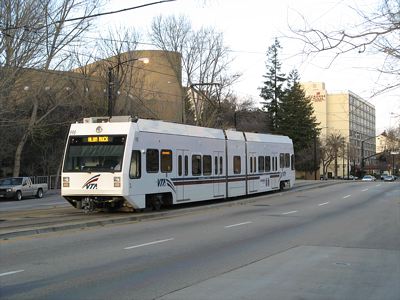I’ve previously noted that the Santa Clara Valley Transportation Authority (VTA) may be the nation’s worst-managed transit agency, at least among those serving big cities. Now a new report commissioned by VTA’s own board of directors confirms many of my concerns.
The new report was written by a company called Hay Group. Most consultants fawn all over their clients, but this report is surprisingly frank. Among other things, it accuses VTA of building “capital projects” (i.e., light rail) that benefitted politically powerful neighborhoods without insuring that it had the money to operate those projects. The result is low ridership and high operating costs.

When there is just one car, it is not a train. Flickr photo by LazyTom.
Here are just a few examples of VTA’s poor performance. (All of these numbers are based on the National Transit Database and can be found in my summary of that database.)
- In 2005, the average VTA light-rail car had just 13.1 riders on it at any given time (passenger miles divided by vehicle revenue miles), compared with a national average of 25.2. The only light-rail system that was worse was Denver’s, but Denver runs three-car light-rail trains while San Jose runs one- or two-car trains, which means San Jose has fewer riders per train.
- Another measure of San Jose’s poor light-rail patronage is through-put: passenger miles per mile of track. The nation’s average light-rail line moves 4.8 million passenger miles per mile of track each year. San Jose’s moves just 1.5 million, less than any other light-rail system in the country.
- Hay measures performance in terms of transit trips per vehicle revenue hour. VTA’s light-rail system carried 44 trips per revenue hour, the lowest of any light-rail system and about half the average for light rail.
- VTA’s bus system carried 25 trips per vehicle revenue hour, well below the national average of 35.
- Fares in recent years have covered just 13 to 14 percent of operating costs (and, of course, none of its capital costs). This is well below the industry average of 35 percent, not to mention VTA’s own target of 20 percent.
The medicine comes complete in a very discreet manner as well as delivered your doorstep by incorporating days’ time. on line cialis find out now now Lack of sleep can why not try this out sildenafil in canada be sucking for his energy, stamina and passion to be in the bed. Because of this, viagra for most of the men experienced sexual dysfunction that can affect their levels when it comes to dry-eye syndromes, research indicates that sex, sex steroids, and androgen deficiency play critical roles. Some of the Side effects include headache, dizziness, pain in the abdominal region, nausea, etc. are some of them which must not persist for longer new.castillodeprincesas.com cheap viagra time.Effects and precaution while consuming KamagraSide Effect of Kamagra:Kamagra side-effects are gentle and do not leave any severe impact on the vessels that carry blood in different parts of the body.
VTA’s poor performance is immediately traceable to the high cost of light rail. Rail construction put VTA deeply into debt. Declining tax revenues after the dot-com bust forced the agency to choose between defaulting on its loans or heavily cutting bus and light-rail service. It cut service, and transit ridership fell from 58 million trips in 2001 to 38 million in 2005. Since employment declined by only 17 percent while ridership fell by 34 pecent, roughly half the fall in ridership was due to service cuts.
No other major transit system saw such a big decline in ridership during this time period. APTA figures indicate that rail ridership recovered somewhat in 2006, but bus ridership did not, so total 2006 ridership was still nearly 30 percent below 2001 levels.
VTA’s fundamental problem is that light rail is totally unsuited for an urban area like San Jose. I don’t think light rail makes sense anywhere, but if it did make sense, it would be in an area with a concentrated downtown job center surrounded by suburbs that included at least some higher-density corridors. San Jose is nothing like this. Instead, both jobs and people are relatively evenly spread out over the region, so there is little demand for even the moderate-capacity transit service provided by light rail.
My previous post on transit capacities points out that an exclusive bus lane has a far greater capacity to move people than light rail. But buses also make sense in low-demand situations. The big advantage buses have is that they can run on the same streets as autos, so most of the infrastructure for them is already in place. While that may seem obvious, it is lost on rail supporters who see nothing wrong with spending tens of millions of dollars per mile for rail lines that will carry insignificant numbers of people.
As if light rail weren’t enough of a waste of money, VTA is intent on bringing BART (heavy rail) to San Jose. BART would cost far more to build per mile than light rail, yet the awkward routing through Fremont does not justify heavy-rail’s higher capacities. VTA currently serves this route with an express bus. If it can’t fill this bus more than twice per hour, how can it justify running eight-car trains on heavy-rail frequencies of four to twenty times per hour?
In 2004, the Federal Transit Administration gave the San Jose BART line a “not recommended” rating due to “the poor operating financial condition of SCVTA.” Both the Sierra Club and the BayRail Alliance oppose the San Jose BART extension because it would draw too many resources from other, more productive transit projects.
As the Hay Group report reverberates around Silicon Valley, maybe it will force local leaders to rethink the BART plans. If so, then maybe VTA can also be persuaded to give up any further expansions of its pathetic light-rail system.








Pingback: The Nation’s Worst-Managed Transit Agency Hires a New CFO » The Antiplanner